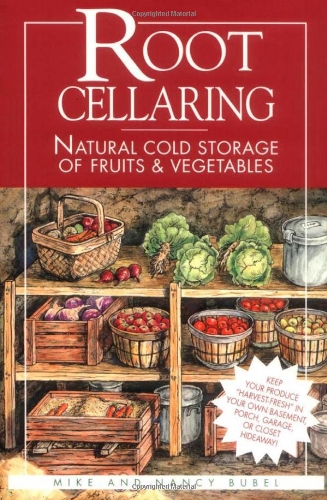
Anyone can learn to store fruits and vegetables safely and naturally with a cool, dark space (even a closet!) and the step-by-step advice in this book.
Root Cellaring: Natural Cold Storage of Fruits & Vegetables
Posted on by admin

You May Also Like
More From Author
Scenes from “The Woking Dead” (HUMOR)
December 4, 2024
How to Make a DIY Water Filter (With Pics)
December 4, 2024
3Comments
Add yoursComments are closed.
















Encyclopedia of no-energy food preservation,
This book is a vast resource of information about root cellars, how to build them, and how to use them. The Bubels contend that even city apartments dwellers can arrange some sort of cold food storage area with a little imagination and a few suggestions from those who have done it before. The book has 6 parts: choosing good storage vegetable varieties, harvesting for keeping quality, storing crops in the root cellar, root cellar ideas for those who don’t currently have a root cellar, root cellaring experiences, and recipes. At the end of the book is a bibliography for further reading, a list of plant sources, and an index. The book is amply illustrated with diagrams and black-and-white photographs.
I didn’t expect to find much in this book that I haven’t read elsewhere. Since my house didn’t come with a root cellar, I wasn’t very optimistic about finding anything in the book that I could use. Fortunately, I was way off-base in these assumptions. I was amazed at the variety and detail of information that the Bubels provide. The sections on choosing seed varieties and determining when to harvest are extremely useful, even if you’re only going to put your harvest in the refrigerator. They also explain the different types of storage conditions required for different crops- -some like it cool and moist, and others warmer and dry. But what gave me real hope was all the ideas about un-root cellars that people have constructed and made good use of for storing vegetables. Their examples include everything from insolated window baskets for apartment dwellers to buried package trucks. One idea that might work well for my situation at least for the time being is a buried refrigerator. Down the line, if I have extra time on my hands, I could trade up for a real dug root cellar, following the plans in the book. If you’re a gardener, you’ll find something of use for sure in this book.
Was this review helpful to you?

|Very clear advice for hanging onto your harvest longer.,
This is a great book for (food) gardeners and for people who have some land available to them. Although there are suggestions for “nooks and crannies” in your house, most of those ideas sound like ideas for older (draftier) homes.
The suggestions for building your own working root cellar are clear, with illustrations to help you plan. There are lists of things that keep well and under what conditions to keep them. The authors even list certain varieties of (for instance) apples that keep better than others. There’s a month-by-month plan of what could be coming out of your garden, going into the root cellar, and what could be canned or frozen. If you have a large garden, this is an incredibly useful book.
However, those of us with smaller modern homes, smaller yards, and smaller, less heavily-producing gardens will be a little disappointed. As I read this, I came to the conclusion that it would be pretty darned difficult to have a root cellar on our property, because we don’t have a useable cool north corner to put one in. Not impossible, mind you, it would just take a lot more effort, planning, and money to build it.
I recommend this book highly for people who raise substantial amounts of their own produce. This book will really extend your harvest. With imagination and a little time and effort, you can have a root cellar that keeps your family in fresh food you grew all year long.
Was this review helpful to you?

|This book gives the complete root cellaring picture.,
We’re fortunate to have bought a property with a well designed root cellar already in place. Until I read this book, I had no idea how a root cellar ‘worked’. This book suggests what foods are best for root cellaring, how long to expect to store them, and what temperatures should be maintained. Had I not read this book I would have wasted time and enery, and lost the nutrients in some foods by canning them rather than root cellaring them. A city dweller friend of mine borrowed my book and has decided to buy it. There are variety of good root cellar plans complete with illustrations and drawings for nearly any situation.
Was this review helpful to you?

|